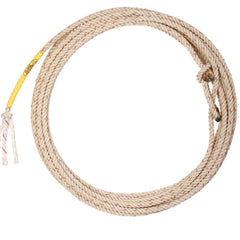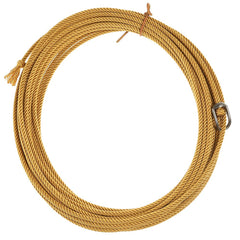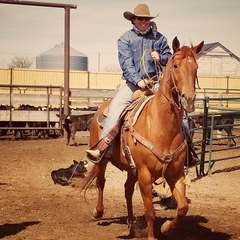
Choosing the Best Ranch Rope For You
There are several factors to take into consideration that will help you pick the best ranch rope for you - the type of roping you'll be doing, the feel, the size/diameter, the length, and the material the rope is made from. As we dive into the ranch ropes at NRS and explain their different attributes, you’ll be able to pick the best ranch rope to fit you and your needs.

The Feel
Each rope is going to have a different feel, depending on the material it is made from and the climate that you’re using the rope in. The temperature and humidity have a lot to do with the way your rope feels, because each matreial poly, nylon, or a poly-nylon blend react to those conditions. The rope will either become more stiff and rigid or let off a tick and limber up. Keeping this in mind, you need to pick a rope that you’re going to be comfortable using if the stiffness does fluctuate a little with the weather.

The Diameter
The diameter of the rope does not only determine how it feels in your hand but also the weight and strength of the rope. Some common diameters in ranch ropes are 5/16, 3/8, and 7/16. If you have smaller hands, a 7/16” may not be the rope for you because managing the coils and reins may be too much to hold in one hand. The diameter also plays a part in determining the weight of the rope simply by the amount of material packed into each strand of your rope. The weight of the rope you use will be a matter of preference. However, you will need to use a rope suitable for your conditions. If you’re ranching in Wyoming, you don’t want to be using a rope that is too light because the wind can change the course of your loop. One other thing to consider is what you will be roping and if the diameter of the rope can sustain the weight of what you have caught. A broken rope can be very dangerous to you and your horse. When one breaks, they tend to snap, coming back at you at a great rate of speed, which can take out an eye.

The Length
Ranch ropes commonly range in length from 35’-60’, with some being as long as 120’. This is longer than team ropes which tend to be between 30-35’ and calf ropes which are between 25-28’, Some things to think about when picking the length of rope you want to use are whether you will be roping in a pasture, branding pen, or round pen. Another factor to consider is if you will be tied on hard and fast, or not. You will not want to be much over the 35’ mark if you’re tied on. The last thing to think about when picking a rope length is the amount of coils you will have in your hand and how much rope you can safely manage to hold along with your reins.

The Material
Ranch ropes can be made from a variety of materials, each one serving a different purpose and providing a different feel for the roper. Those materials can range from nylon and poly to braided reatas and maguey ropes. We are going to focus on the materials in the ropes we offer to you.
The material in the body of the rope can be made of twisted nylon, a nylon-poly blend, or a straight poly, along with some being braided nylon or cotton. The eye of the rope is usually made of the same material, just being tied in at one end of the rope with a rawhide or speed burner attached, but some ranch ropes, like the King Quad Poly Gold come with a metal Buck Brannaman style honda, making them backed into the loop after the catch is made to release the pressure of the rope.

Twisted nylon ropes are going to be some of the most common ranch ropes used. They’re very durable and have a bit of stretch to them, helping to act like a bit of a shock absorber when tied to or dallied on the saddle horn. The straight nylon ropes are going to get a bit stiffer in warmer weather and let off a tick in cooler weather. Cashel also makes a braided nylon rope that will act much the same way but has a different feel in the hand because of the lack of ridges a twisted rope has.

The poly-nylon blends will be a bit reactive to the weather but tend to stay more consistent throughout a wide variety of conditions. Along with a consistent feel, they also still offer some stretch, making them a favorite choice of many ranch hands and day workers. A lot of times, the blended ropes that are used for ranching will be either a heel rope that is a softer lay or an older head rope.
Straight poly ranch ropes are often used by those who prefer more weight in the loop of their rope. Polys tend to be more limber and give the roper more tip weight, which can lead to more control of the loop, really allowing the roper to be precise in their delivery and catch. The polys tend to be able to withstand the elements as well, giving them a long life. If there was one drawback to a poly, it would probably be that there is very little stretch in a poly rope.

No matter if you’re starting colts in the round pen, dragging calves in the branding pen, or doctoring cattle on wheat pasture, you will be able to what you just learned and shop our collection of ranch ropes to find the perfect rope to fit your style and get the job done.

